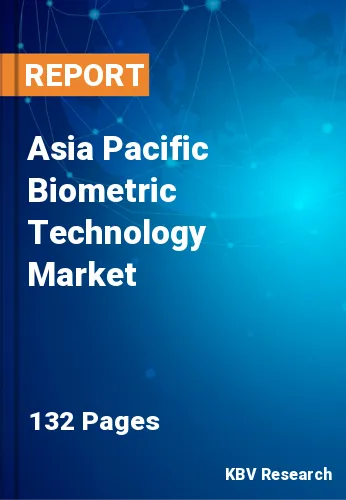The Asia Pacific Biometric Technology Market would witness market growth of 16.0% CAGR during the forecast period (2021-2027).
To create a less obtrusive biometric authentication device, the time consumed for biometrics authentication will have to be considerably reduced. This will also result in fewer tensions, as well as less frustrated and irritated employees. Due to the time spent in ensuring a correct contact with the biometric system, a successful authentication often takes much more time than desired. Poor attempts and incorrect contact can also dramatically increase friction and discomfort for the employees. Other biometric technologies such as voice, facial and even vein pattern identification are rapidly flooding the market as fingerprint recognition becomes more popular. One of the areas that banks and card issuers are exploring into the use of fingerprint identification instead of PIN numbers for contactless card payments.
Investments in biometric systems throughout various regions have increased as a result of increased airport security initiatives and measures to lower crime rates. In industrialized countries, enhanced biometrics is being used to accomplish various government schemes such as e-passports, e-driving licenses, border control, and national IDs. One of the fastest-growing segments in this kind of security solution is IRIS recognition
The Asia Pacific region includes some major economic powerhouses such as India and China. Initiatives using face, fingerprints, and eye biometry, such as Indonesia's e-KTP electronic ID initiative and India's UIDAI project, are projected to open up new economic prospects. The healthcare sector in the region along with consumer electronics and government sectors is projected to encounter a reasonable growth in the implementation of next-generation biometrics. Developing countries like China and India are pushing the use of biometric systems in government sectors. China began a biometric national ID program in 2013, while India began the program in 2011. Biometric systems are gaining traction in these countries. However, as the amount of important papers stored on computers grows, so does the demand for next-generation biometric solutions.
The China market dominated the Asia Pacific Biometric Technology Market by Country 2020, and would continue to be a dominant market till 2027; thereby, achieving a market value of $7,271.1 million by 2027. The Japan market is estimated to grow CAGR of 15.3% during (2021 - 2027). Additionally, The India market would showcase a CAGR of 16.7% during (2021 - 2027).
Based on Type, the market is segmented into Physiological Biometrics and Behavioral Biometrics. Based on Physiological Biometrics Type, the market is segmented into Face Recognition, Fingerprint Recognition, Iris Recognition, Hand Geometry, and Others. Based on Behavioral Biometrics Type, the market is segmented into Signature Recognition, Voice Recognition, and Others. Based on Component, the market is segmented into Hardware and Software. Based on End User, the market is segmented into Public Sector, BFSI, Healthcare, IT & Telecom, and Others. Based on countries, the market is segmented into China, Japan, India, South Korea, Singapore, Malaysia, and Rest of Asia Pacific.
Free Valuable Insights: The Worldwide Biometric Technology Market is Projected to reach USD 85 Billion by 2027, at a CAGR of 14.1%
The market research report covers the analysis of key stake holders of the market. Key companies profiled in the report include NEC Corporation, Thales Group S.A., Fujitsu Limited, ImageWare Systems, Inc., Precise Biometrics AB, BIO-key International, Inc., Secunet Security Networks AG, Suprema, Inc., IDEMIA SAS, and HID Global Corporation.
By Type
By Component
By End User
By Country
Our team of dedicated experts can provide you with attractive expansion opportunities for your business.

